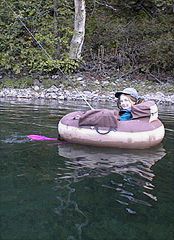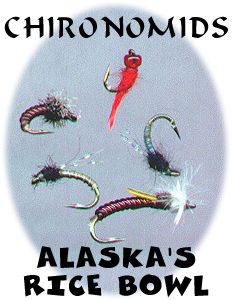- CHIRONOMIDS -
Alaska's Rice Bowl for the Masses
GB: The MIDGE, a diminutive little bug, some so tiny they are almost imperceivable.... while others may grow to giagantic proportions approaching the diameter of a pinhead. So what is all the flap about? Something you can hardly see couldn't hold a candle as an effective pattern compared to other "meat & potatoes" food sources found in Alaska's waters. Ah, but there's the rub. Literally every freshwater fish in Alaska, including the returning adult salmon, owe their very existence to the chironomids....an insect that literally has fed, at one time or another, every freshwater fish in the world.
From sculpin & stickleback to 100 pound chinook and four foot long pike, every fish begins life as a tiny fry whose table fare is reduced to the tiniest of morsels which they can eat. Enter the midge larvae, pupae, and adults. Just as the saying "from acorns mighty oak trees grow" or something like that, so is this small but important insect literally the foundation of Alaska's fisheries existence.
During my formative years of learning the basics of fly fishing one method was always avoided -- "midging" or more accurately portrayed as "fishing with a fly so small you need a magnifying glass to tie it on and even then it required leaders in the 1 lb. test category....or finer." My youthful days of logic and the laws of physical science emphasized that landing a two pound trout on a #20 hook and a spider's web of a line would be shear luck, and the number of flies lost, as well as the frustration experienced would put this far down my list as an enjoyable day on the water.
As one gets older, and wiser, we begin to understand the world from new perspectives and fly fishing has a bit of that same evolution. Somewhere along the line we progressed from practice casting to that hula hoop on the front lawn with your first rod (and your dad at your side) to dropping a grand on a rod/reel combo without even batting an eye. Somewhere inbetween, when the fly fisher discovers the effectiveness of chironomid patterns a new world and experience opens up, and perhaps becomes the very catalyst responsible for buying that thousand dollar outfit later.
To those of you who are considering joining the ranks of fly fishing enthusiasts, or those who are only now working your way up the skill curve, I suggest taking a shortcut and jumping right into fishing with midge patterns. Alaska is a wonderful place to cut your teeth on fishing with these flies....a huge number of our lakes are teeming with rainbows, char, grayling and landlocked chinook and coho salmon ready to take your offering and few if any of those fish will sneer at a less than perfect presentation....or even the way you tied the fly. Heck, most of those fish have never seen an artificial fly or fly-fisher. An evening float-tubing or fishing from a kickboat or canoe where perhaps every third cast is a hookup can provide a memory as rewarding as a journey to New Zealand for their sea-run browns. Well, maybe not quite that memorable, but then again, when you can do it over and over again, every evening, all summer long and just a mile or two down the road....
Pros and Cons
BH: Lesser experienced fly casters may believe that fishing #20's may be satisfying to experienced anglers but requires highly developed skills and equipment. In all actuality I think fishing Chironomids is one of the easiest methods of stillwater fishing in Alaska, and its one of the easiest patterns to tie. When fishing larger subsurface patterns, (e.g. leeches) we often times end up using a sink tip or full sink, or a larger dose of split shot to get the fly down. Line weight and shot added to the fact that large flies get heavy when wet and are wind resistent can make casting a challenge. Then when we do get the fly down, hooking the fish can be surprisingly tough. When the fish takes the fly, it may or may not strike hard. Occasionally they just bump it....either way the fish needs to get the flyline moving through the water to transmit the strike to the angler. Once we do detect the strike we have to again get the flyline moving to set the hook. Unless you're using a stiff rod (difficult to cast for beginners) much of the rod's energy during the hookset response will be spent getting the line moving, possibly leaving too little energy at the fly to sink the larger hook into flesh (larger diameter wire). And all this comes at the expense of critical timing...before a fish decides to reject the fly.
 Lightweight gear and small hooks on the other hand are much easier to cast. Once we get the line out, if we are employing the emerging rise with a small split shot, a strike indicator on the line makes detection easier (for kids...watch the "bobber"). And because most of the line is on TOP of the water with just the leader submerged, and because we generally use less line overall, and because we're using a tiny, incredibly sharp, small diameter wire hook, all that is generally required is to lift the rod tip....at most. Usually the fish will hook themselves! Or, if we're fishing a suspender midge on top, it gets even easier and more fun because you get to watch the fish rise up and eat the fly. I took my 7 y/o daughter float tubing last spring (1999) for the first time on one of my favorite local lakes, and rigged her up with a chironomid on a 4 wt. rod with floating line and an indicator. She can cast about 15 feet adequately and had a fish on before I'd even tied my fly on. Lightweight gear and small hooks on the other hand are much easier to cast. Once we get the line out, if we are employing the emerging rise with a small split shot, a strike indicator on the line makes detection easier (for kids...watch the "bobber"). And because most of the line is on TOP of the water with just the leader submerged, and because we generally use less line overall, and because we're using a tiny, incredibly sharp, small diameter wire hook, all that is generally required is to lift the rod tip....at most. Usually the fish will hook themselves! Or, if we're fishing a suspender midge on top, it gets even easier and more fun because you get to watch the fish rise up and eat the fly. I took my 7 y/o daughter float tubing last spring (1999) for the first time on one of my favorite local lakes, and rigged her up with a chironomid on a 4 wt. rod with floating line and an indicator. She can cast about 15 feet adequately and had a fish on before I'd even tied my fly on.
You know, another misconception is that fish take these puny bugs only when there's nothing better to eat, but in reality they're probably the single most important sustainable food for the majority of trout, and for that matter, every freshwater fish in Alaska. Well, we can't really include all the adult trout in Alaska because some have the salmon and smolt thing going in open system rivers/lakes, but midges of different forms are incomprehensibly prolific in lots of places. Sure the other hatching insects are more glamorous and draw lots of attention when they're coming off, but that's the key. When they're coming off. Heck some famous hatches just fail to happen some years and the fishermen that traveled hundreds of miles to fish the Green Drakes are standing on the river bank wondering what to do now. And some hatches like the Giant Stones come off for a two week period, if they come off. Midges on the other hand hatch all the time... every single day of the year in some areas. And in the lakes... sometimes you can't even breathe because there's so many of the things in the air. And you pump a fish stomach and it's filled with black goo that must be a thousand of the buggers, but that's what they're eating. I think that people just don't like to fish them. They can be more difficult, but some people love 'em so much they specialize in "midging." Opps, there's that urge for a thousand dollar outfit. I've done a fair amount of it on the Green and San Juan in Utah and it really is a kick. What you fish with are flies that imitate midge clusters. When they mate they end up in these little orgy balls and that's what the fish key on. More bang for the buck for each effort.
For the fly tier who may not have tied this pattern, one of the easiest mental images to focus on is a mosquito larvae. Nearly everyone has seen these annoying little bugs in bird baths, rain puddles, and even coffee cans holding water. Well guess what....a mosquito belongs in the Midge group and its "wriggler" or larvae (about a #14-16) has all the characteristic body parts and profile you want to imitate for your own patterns. Most other chironomids usually have their larval stage living in the gravel, sand or sediments and mud of the lake or stream bottom for protection from predators until their time to emerge as a fly. It is during this single minute or two in their lives that so many are taken by fish.
The chironomids are the first insects to emerge in the Spring as the ice cover on area lakes disappears. The longer daylight hours and warmer water triggers their final development and sets in motion a feeding pattern the fish rely on throughout the summer until freeze-up. Whether you are fishing Alaska's wild lakes and native stocks or trying your local lake that has been stocked by Fish & Game, the results are the same. Lake resident rainbows, char, grayling and landlocked (stocked) chinook and coho salmon all depend on midges for a significant contribution to their protein demands. These insects may be tinier than a grain of rice, but their importance in the ecosystem ranks them as an essential component of each fish's diet. Every Alaskan fly fisher should have a fly box dedicated to a wide variety of chironomid patterns in larva, emerger and dry variations.
Tight lines and good fishing!
|

